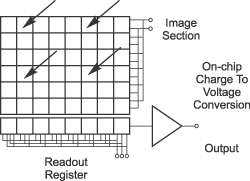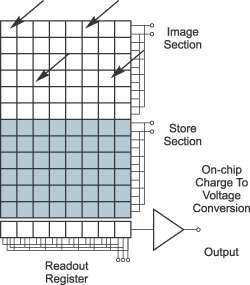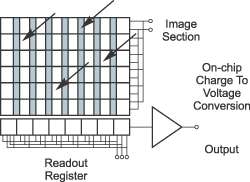Resources
 Part of the Oxford Instruments Group
Part of the Oxford Instruments Group
Expand
Collapse
 Part of the Oxford Instruments Group
Part of the Oxford Instruments Group
The CCD architectures commonly used for high performance cameras are described below:

The full frame CCD is the simplest form of sensor in which incoming photons fall on the full light sensitive sensor array. To readout the sensor, the accumulated charge must then be shifted vertically row by row into the serial output register and for each row the readout register must be shifted horizontally to readout each individual pixel. This is known as "Progressive Scan" readout. A disadvantage of full frame is charge smearing caused by light falling on the sensor whilst accumulated charge signal is being transferred to the readout register. To avoid this, devices sometimes utilise a mechanical shutter to cover the sensor during the readout process. However, mechanical shutters have lifetime issues and are relatively slow. Shutters are not needed however in spectrographic operations or when a pulsed light source is used. Full frame CCDs are typically the most sensitive CCDs available and can work efficiently in many different illumination situations.

The frame-transfer CCD uses a two-part sensor in which one-half of the parallel array is used as a storage region and is protected from light by a light-tight mask. Incoming photons are allowed to fall on the uncovered portion of the array and the accumulated charge is then rapidly shifted (in the order of milliseconds) into the masked storage region for charge transfer to the serial output register. While the signal is being integrated on the light-sensitive portion of the sensor, the stored charge is read out.

Frame transfer devices have typically faster frame rates than full frames devices and have the advantage of a high duty cycle i.e. the sensor is always collecting light. A disadvantage of this architecture is the charge smearing during the transfer from the light-sensitive to the masked regions of the CCD, although they are significantly better than full frame devices. The frame transfer CCD has the sensitivity of the full frame device but are typically more expensive due to the larger sensor size needed to accommodate the frame storage region.
The interline-transfer CCD incorporates charge transfer channels called Interline Masks (see figure on right). These are immediately adjacent to each photodiode so that the accumulated charge can be rapidly shifted into the channels after image acquisition has been completed. The very rapid image acquisition virtually eliminates image smear. Altering the voltages at the photodiode so that the generated charges are injected into the substrate, rather than shifted to the transfer channels, can electronically shutter interline-transfer CCDs.

Interline devices have the disadvantage that the interline mask effectively reduces the light sensitive area of the sensor. This can be partially compensated by the use of microlens arrays to increase the photodiode fill factor. The compensation usually works best for parallel light illumination but for some applications which need wide angle illumination (small F/# number) the sensitivity is significantly compromised.
Date: N/A
Author: Andor
Category: Application Note
